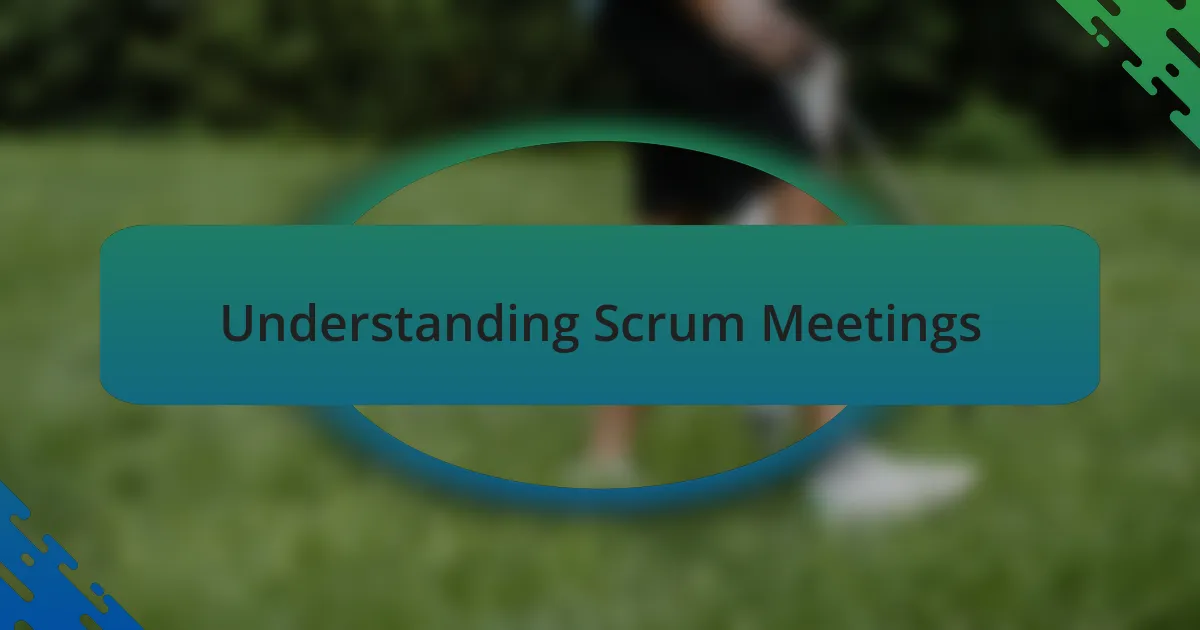Key takeaways:
- Scrum meetings foster collaboration and transparency, with clearly defined roles enhancing team contributions.
- Challenges such as differing opinions, time management, and personality dynamics can hinder meeting effectiveness.
- Implementing a clear agenda and timeboxing discussions can significantly improve meeting productivity.
- Creating psychological safety allows all team members to share ideas, enhancing the quality of feedback and input.

Understanding Scrum Meetings
Scrum meetings are fundamental components of the Agile framework, promoting collaboration and transparency within teams. I still remember my first daily stand-up, feeling a mix of excitement and anxiety. The atmosphere buzzed with a shared commitment to progress; it was clear this meeting wasn’t just routine—it was a vital touchpoint that kept everyone aligned and motivated.
When it comes to Scrum, the roles can often feel overwhelming. I sometimes found myself questioning, “What am I supposed to do here?” But as I grasped the structure—such as the Product Owner, Scrum Master, and the Development Team—I realized each role plays a crucial part in driving the project forward. This clarity allowed me to navigate meetings more confidently, contributing more effectively to discussions.
Reflecting on Sprint Planning, I’ve discovered it’s more than just a scheduling exercise; it’s where the magic of collaboration happens. I vividly recall a session where we hashed out requirements, and the energy in the room was palpable. Instead of feeling like a chore, it became a creative endeavor that shaped the direction of our work, reinforcing the importance of each member’s voice in the Scrum process.

Challenges Faced During Scrum Meetings
Scrum meetings can sometimes become a battleground of differing opinions, making it challenging to reach consensus. I recall a particularly heated discussion during a review meeting where stakeholders had contrasting views on priorities. It was moments like these that tested our ability to communicate effectively and remain constructive, leaving me wondering, “How do we keep the team focused on solutions instead of disagreements?”
Another challenge I’ve faced is time management—sometimes, discussions can veer off-course, taking longer than planned. I distinctly remember a retro meeting that started off on track but quickly spiraled into a deep dive of unrelated issues. It left me feeling frustrated because we had so much to cover, yet I learned the importance of having a strong facilitator to steer conversations back to the agenda.
Dealing with different personality types in Scrum meetings has also proven to be tricky. I’ve worked with individuals who dominate discussions, making it hard for quieter team members to share their input. This dynamic often makes me reflect on how vital it is to create an inclusive environment where everyone feels safe to voice their ideas, leading me to question what strategies we can implement to ensure all voices are heard.

Strategies for Productive Scrum Meetings
One effective strategy I’ve found is to set a clear agenda before the meeting starts. This simple act has made a noticeable difference in my experience, ensuring that each participant knows what to expect and can come prepared. I often ask my team, “What key points should we tackle today?” This collaborative approach not only enhances focus but also encourages everyone to take ownership of the discussions.
Timeboxing discussions is another technique I’ve seen work wonders. I remember a sprint planning session where we allocated specific time slots for each topic. It was eye-opening to see how much more we accomplished when we knew we had a deadline for our conversations. I found myself thinking, “Why didn’t we do this sooner?” This method not only keeps us on track but also fosters a sense of urgency that can drive more productive outcomes.
Lastly, fostering an atmosphere of psychological safety has been crucial in my experience. I’ve noticed that when team members feel secure in sharing their thoughts, even the quietest voices can contribute meaningful insights. During a retrospective meeting, we implemented a ‘silent brainstorm’ where everyone wrote their ideas before discussing them. I was amazed at the depth of feedback we received. Isn’t it interesting how sometimes the best strategies come from simply changing how we invite participation?